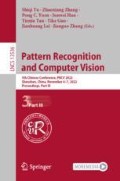Abstract
This paper explores how artificial intelligence (AI) technology can contribute to achieve progress on good health and well-being, one of the United Nations’ 17 Sustainable Development Goals. It is estimated that one in ten of the global population lived with a mental disorder. Inspired by studies showing that engaging and viewing beautiful natural images can make people feel happier and less stressful, lead to higher emotional well-being, and can even have therapeutic values, we explore how AI can help to promote mental health by developing automatic algorithms for finding beautiful and happy images. We first construct a large image database consisting of nearly 20K very high resolution colour photographs of natural scenes where each image is labelled with beautifulness and happiness scores by about 10 observers. Statistics of the database shows that there is a good correlation between the beautifulness and happiness scores which provides anecdotal evidence to corroborate that engaging beautiful natural images can potentially benefit mental well-being. Building on this unique database, the very first of its kind, we have developed a deep learning based model for automatically predicting the beautifulness and happiness scores of natural images. Experimental results are presented to show that it is possible to develop AI algorithms to automatically assess an image’s beautifulness and happiness values which can in turn be used to develop applications for promoting mental health and well-being.
Supported by Guangdong Key Laboratory of Intelligent Information Processing, Shenzhen, China, Shenzhen Institute for Artificial Intelligence and Robotics for Society, Shenzhen, China, and Shenzhen Key Laboratory of Digital Creative Technology, Shenzhen, China.
Access this chapter
Tax calculation will be finalised at checkout
Purchases are for personal use only
References
Van den Berg, M.M.H.E., et al.: Autonomic nervous system responses to viewing green and built settings: differentiating between sympathetic and parasympathetic activity. Int. J. Environ. Res. Public Health 12(12), 15860–15874 (2015)
Zhang, J.W., Howell, R.T., Iyer, R.: Engagement with natural beauty moderates the positive relation between connectedness with nature and psychological well-being. J. Environ. Psychol. 38, 55–63 (2014)
Vincent, E.A.: Therapeutic benefits of nature images on health. Clemson University (2009)
Reynolds, L., et al.: Virtual nature as an intervention for reducing stress and improving mood in people with substance use disorder. J. Addict. 2020, 1–7 (2020)
Reber, R., Schwarz, N., Winkielman, P.: Processing fluency and aesthetic pleasure: Is beauty in the perceiver’s processing experience? Pers. Soc. Psychol. Rev. 8(4), 364–382 (2004)
Machajdik, J., Hanbury, A.: Affective image classification using features inspired by psychology and art theory. In: Proceedings of the 18th ACM International Conference on Multimedia, pp. 83–92 (2010)
Achlioptas, P., et al.: Artemis: affective language for visual art. In: Proceedings of the IEEE/CVF Conference on Computer Vision and Pattern Recognition, pp. 11569–11579 (2021)
Zhang, J.W., et al.: An occasion for unselfing: beautiful nature leads to prosociality. J. Environ. Psychol. 37, 61–72 (2014)
Mastandrea, S., Fagioli, S., Biasi, V.: Art and psychological well-being: linking the brain to the aesthetic emotion. Front. Psychol. 10, 739 (2019)
Diener, E., Scollon, C.N., Lucas, R.E.: The evolving concept of subjective well-being: the multifaceted nature of happiness. In: Diener, E. (eds.) Assessing Well-Being. Social Indicators Research Series, vol. 39. Springer, Dordrecht (2009). https://doi.org/10.1007/978-90-481-2354-4_4
Wang, Z., et al.: Brain-inspired deep networks for image aesthetics assessment. arXiv preprint arXiv:1601.04155 (2016)
Jin, X., et al.: ILGNet: inception modules with connected local and global features for efficient image aesthetic quality classification using domain adaptation. IET Comput. Vision 13(2), 206–212 (2019)
Rao, T., et al.: Multi-level region-based convolutional neural network for image emotion classification. Neurocomputing 333, 429–439 (2019)
Zhao, S., et al.: Computational emotion analysis from images: recent advances and future directions. Hum. Percept. Visual Inf. 21, 85–113 (2022)
Ulrich, R.S.: Aesthetic and affective response to natural environment. In: Behavior and the Natural Environment, pp. 85–125. Springer, Boston (1983). https://doi.org/10.1007/978-1-4613-3539-9_4
Kahn, P.H., Jr., Severson, R.L., Ruckert, J.H.: The human relation with nature and technological nature. Curr. Dir. Psychol. Sci. 18(1), 37–42 (2009)
Diessner, R., Solom, R.D., Frost, N.K., et al.: Engagement with beauty: appreciating natural, artistic, and moral beauty. J. Psychol. 142(3), 303–332 (2008)
Brown, D.K., Barton, J.L., Gladwell, V.F.: Viewing nature scenes positively affects recovery of autonomic function following acute-mental stress. Environ. Sci. Technol. 47(11), 5562–5569 (2013)
Nanda, U., Eisen, S., Zadeh, R.S., et al.: Effect of visual art on patient anxiety and agitation in a mental health facility and implications for the business case. J. Psychiatr. Ment. Health Nurs. 18(5), 386–393 (2011)
Dubey, S.R.: A decade survey of content based image retrieval using deep learning. IEEE Trans. Circuits Syst. Video Technol. 32(5), 2687–2704 (2021)
Huang, G., et al.: Densely connected convolutional networks. In: Proceedings of the IEEE Conference on Computer Vision and Pattern Recognition, pp. 4700–4708 (2017)
Lu, X., et al.: Rapid: rating pictorial aesthetics using deep learning. In: Proceedings of the 22nd ACM International Conference on Multimedia, pp. 457–466 (2014)
Zhou, et al.: Places: a 10 million image database for scene recognition. IEEE Trans. Pattern Anal. Mach. Intell. 40(6), 1452–1464 (2017)
Author information
Authors and Affiliations
Corresponding author
Editor information
Editors and Affiliations
Rights and permissions
Copyright information
© 2022 The Author(s), under exclusive license to Springer Nature Switzerland AG
About this paper
Cite this paper
Xie, R., Qiu, C., Qiu, G. (2022). Finding Beautiful and Happy Images for Mental Health and Well-Being Applications. In: Yu, S., et al. Pattern Recognition and Computer Vision. PRCV 2022. Lecture Notes in Computer Science, vol 13536. Springer, Cham. https://doi.org/10.1007/978-3-031-18913-5_54
Download citation
DOI: https://doi.org/10.1007/978-3-031-18913-5_54
Published:
Publisher Name: Springer, Cham
Print ISBN: 978-3-031-18912-8
Online ISBN: 978-3-031-18913-5
eBook Packages: Computer ScienceComputer Science (R0)

